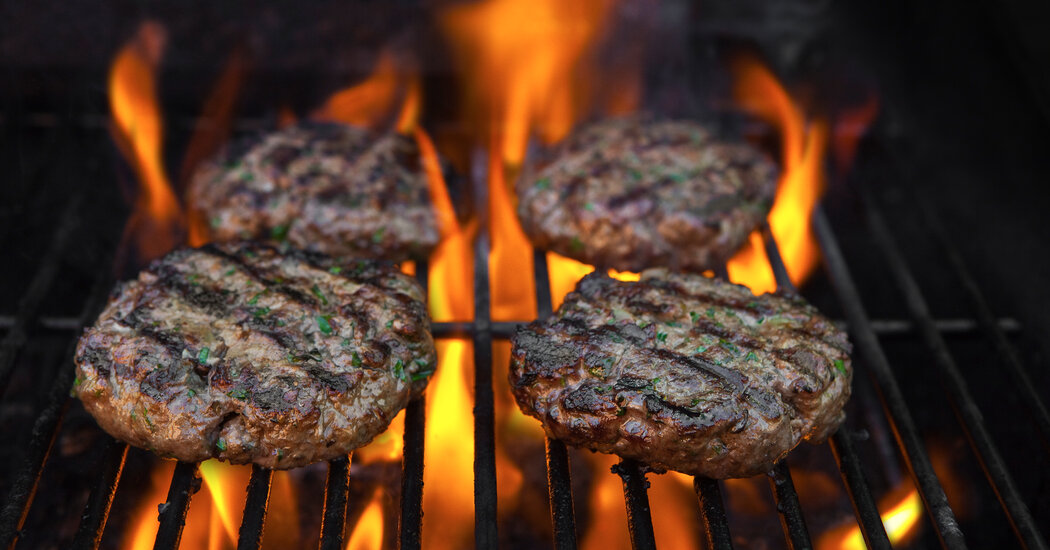Most American burgers are, in fact, not entirely American.
The patties grilled at backyard barbecues or flipped in fast-food restaurants are often a blend of ground beef, both homegrown and imported from other countries, especially Brazil. In school cafeterias and home kitchens, this global mix of beef is seared, fried and sizzled into millions of tacos, meatballs and lasagnas every day.
Now, President Trump’s dismantling of the global trading system through his imposition of broad-based tariffs is leading to shifts in commerce that could make winners out of countries like Brazil that produce commodities the world covets.
When it comes to beef — crucial to satisfying Americans’ hunger for cheap cuts of meat — tariffs will make Brazilian beef more expensive.
But at the same time, Brazil is suddenly a more appealing source for China, another enormous consumer of beef, because its trade war with the United States — and the high tariffs the two nations have imposed on each other — has left China looking for other countries with ample supplies of inexpensive meat.
While U.S. meatpackers, most likely anticipating escalating prices, have been stocking up on Brazilian beef in recent weeks, according to trade data, Brazilian beef exports to China also increased in April.
As a result, prices for commodity beef from Brazil have increased by about 20 percent since early April, trade experts say.
“The moment, from our point of view, has never been more favorable to Brazil,” said Luiz Gustavo Oliveira, the vice president of Grupo Fribal, a Brazilian meat company. “And the world has its doors open to Brazilian meat.”
U.S. meat processors, on the other hand, are struggling to grapple with higher beef prices and what they mean for their bottom lines and how much their customers will be asked to pay.
In a bid to keep prices down, Kent Sander, whose family owns a meat-processing business in rural Indiana, has begun mixing pork, which is less expensive, into the beef burgers he sells. “I’m trying to give people an affordable option,” he said.
Brazil is the world’s biggest exporter of beef, having surpassed the United States in the past 20 years. With vast swaths of farmland where enormous cattle herds can graze, and lower labor and other related costs, Brazilian ranchers have conquered the global market by producing beef on a larger scale and far more cheaply than its competitors.
China and the United States are the top two buyers of Brazilian beef, with both countries sharply increasing their purchases in recent years to keep up with growing domestic appetites for lean, inexpensive meat that neither country’s farmers can satisfy.
“Brazil is in a unique position,” Roberto Perosa, the president of the Brazilian Association of Meat Exporting Industries and a former trade secretary for the Brazilian government. “No other country in the world can meet this demand.”
While the United States is still the world’s biggest producer of beef, its cattle — fattened up on a soy or corn diet — is better suited for expensive, marbled steaks famous for their rich flavor, according to U.S. industry experts.
Some of this cattle is slaughtered to produce cheaper cuts of beef. But a large portion is turned into premium steaks like filet mignon or rib-eye, which are consumed at home and at steakhouses, or exported to the rest of the world. China, the third-largest buyer of U.S. beef, imported $1.6 billion worth of meat in 2024.
To churn out the cheaper ground beef that many Americans eat daily, U.S. meatpackers mix fattier, local beef with leaner, grass-fed varieties from abroad.
“Not all beef is equal,” said Glynn Tonsor, a professor of agricultural economics at Kansas State University. “And in the U.S., we consume more ground beef than we produce.”
To meet the demand, the United States increased its beef imports from Brazil from 2023 to 2024 by more than 50 percent, reaching a record $1.3 billion.
But Brazilian beef is now subject to the 10 percent tariff Mr. Trump applied on just about every U.S. trading partner, and the longer the tariffs persist, the more likely they are to reshape the global beef trade in lasting ways.
President Luiz Inácio Lula da Silva of Brazil said recently that he did not want to “make a choice” between China and the United States, the nation’s two largest trading partners.
“I want to negotiate with everyone,” said Mr. Lula, who is scheduled to visit China this month. “I want to sell and buy.”
But Mr. Lula’s top foreign policy adviser, Celso Amorim, told a Brazilian newspaper that China now offers Brazil “more opportunities and fewer risks” than the United States.
And after China revoked the export licenses of more than 390 U.S. meat-processing companies in retaliation for U.S. tariffs, Brazil’s agricultural minister said the Latin American country was eager to fill the gap.
“Someone will need to supply this meat, which was supplied by the Americans,” said the minister, Carlos Fávaro.
In China, a long-held preference for cheaper pork has been giving way to a newfound taste for steaks and beef hot pots in recent years, as the country’s middle class has grown.
Chinese beef imports rose from less than $100 million in 2010 to over $13 billion in 2024, with the country buying nearly half of its beef from Brazil last year.
Most Brazilian beef was already subject to steep U.S. tariffs, first put in place in the 1990s to shield American cattle ranchers from a flood of cheaper imported beef. Now, Mr. Trump’s recent tariffs have pushed the levy to 36 percent. By comparison, Brazilian beef faces tariffs of only 12 percent in China.
With China mostly halting U.S. beef imports, supply chains for “this commodity have been completely shaken,” said André Ferreira, a Brazil-based maritime transport specialist at DMS Logistics. “So China will look at Brazil differently now.”
Some Brazilian beef producers are already charting ambitious plans for the future.
For Grupo Fribal, which raises, slaughters and packages beef for domestic and international markets, business has been booming in recent years, as exports to China and the United States have surged.
Now, the company plans to increase its cattle herd to 60,000 from 40,000 by next year, in part to take advantage of even stronger demand spurred by tariffs. “The moment is now,” said Mr. Oliveira of Grupo Fribal.
But breeding, raising and fattening more cattle for beef takes time and money, making such plans a long-term bet that demand will continue growing.
Brazil, an immense nation with a mild climate favoring agriculture, has more cattle than people. Since the 1970s, both large-scale ranching and family farming have spread across every region of the country, including the Amazon rainforest.
Still, back-to-back droughts have taken a toll, with Brazil’s beef production expected to shrink by nearly 5 percent in 2025, according to Safras & Mercado, a consultancy.
And even if some Brazilian ranchers are able to increase production in the short term, they may struggle to ship more beef abroad as major Brazilian ports are already operating near full capacity.
In the United States, trade experts say American farmers will be hard pressed to replace beef imports from Brazil and were wrestling with other challenges before the tariffs. U.S. cattle inventories have fallen to a 73-year low, partly because of drought and rising costs of animal feed.
Demand for cheaper beef is expected to increase as economic jitters pull U.S. consumers away from expensive cuts and toward burgers, pushing up prices. Ground beef prices in U.S. cities have climbed 43 percent over the past five years, according to the U.S. Bureau of Labor Statistics.
Even with tariffs, the United States will most likely continue relying on Brazilian beef because there is no other similarly large source for the American market, experts said.
This may be good news for Brazil’s cattle ranchers, said Mr. Perosa, of the meat exporting association, but not for U.S. consumers. “It’s American society that will have to foot the bill,” he said.


